 |
TimeDomain Corporation has been in research to looking for good sound since its foundation.
One of the basic technological theory is "time domain".
The series of articles were appeared in "Radio Technology" magazine from July to October in 1983.
The concept of "Time domain" is explained very clearly to understand in these articles.
So, please enjoy reading to help your understanding.
Although it had been written more thatn 19 years ago, its theory and technology hold good even today as long as you consider the change of environmental situation.
We will link new material and information from that time down to this day into the main body additionally without changing the original article.(980904)
|
|
- Why physical characteristics do not match with the sense of hearing?
-
Nowadays, many people consider that in most cases frequency and
distortion characteristics are not match with the sense of hearing by conventional methods. Are there any mistakes in the way of detection? Or, do we need another approach? If we pay attention to the basic issues, what kind of new aspects will appear? Nowadays, many people consider that in most cases frequency and distortion characteristics are not match with the sense of hearing by conventional methods. Are there any mistakes in the way of detection? Or, do we need another approach? If we pay attention to the basic issues, what kind of new aspects will appear? These are main subjects in this article. Especially, we have to pay a big attention to the time axis distortion in the future.
(Editor)
New audio products are coming out into the market one after another. Always with copy "how to playback faithful sound ". Most cases only mentioning "make frequency response flat and better to reduce harmonic distortion", not about its technique and theory.
But, we can not playback music sound faithfully with only frequency response and distortion. Those are important factors for sound playback, but not enough if other important factors are inferior.
I would like to present some important subjects which have been neglected. Let's think together, and I would like to accomplish an audio technique which satisfy us all in music playback. The neck is a speaker system as everybody admits. So in this article, I will carry on with this subject.
Speaker system has been remaining as it is for 10 years, 20 years, even more than 50 years in this rapid progressing society. It is impossible for other industrial products to stay in the market like this way.
If you can understand music well, it will be possible to create excellent sound speaker-system by making the best use of high technique, engineering method, and new way of thinking.
Distortion relating to time axis
Proposal on Multipath-ghost distortion
Playbacked sound has very unique tone that everybody can recognize as " playbacked sound".
If you input impulse signal to the system, it would sound like "crack" and "slap". (Fig. No. 1) Looks like some reflection is main reason for causing overlapped sound of the impulse which should sound like "puff" .
You can get the pattern on Fig. No. 2 , if you move a microphone inside a horn-type-speaker, and change arrangement of the impulse response data obtained at 50 points on the center axis by computer.
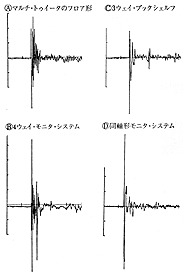 | 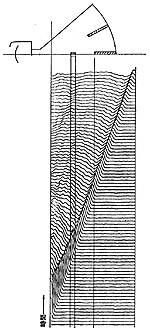 |
| <Fig. No. 1> Impulse response examples of various speakers |
| <Fig. No. 2> Sound wave disorder inside sectoral-horn-> |
It shows very clearly the way of traveling of the impulse wave inside horn according to time.
The impulse wave which hits a prop or a separator will reflect and return. The music sound will be changed by this phenomenon. For example, high-level area will become noisy, sounds poor, very hard to tell the nuance of the string and vocal, or sounds gorgeous and pleasant, etc.
We would like to call these phenomena as "multipath-ghost distortion", since it is very similar to the ghost on TV. We can learn about small reflection by using self-correlative function and the technique of "power-capstrum". The higher correlation between two sound signals which is apart t:time in the time axis data, the higher reflection sound existence probability.(Fig.No. 3). In this figure, you can recognize that multipath-ghost distortion is 10%.
 | 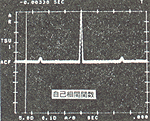 |
| <Fig. No. 3> Impulse accompanying -20dB reflection delay and its self-correlative function |
By the way, it is very difficult to find out multipath-ghost distortion if you use sine wave, even though you listen into very carefully and try to measure it out.
Sine wave of 1kHz is a pure sine wave of 1kHz even you put many sine waves one over another (Fig. No. 4). When you sweep frequency, you can find unevenness in frequency response by its inter ference. But it will be under 0.1dB in case of 1% ghost distortion, and not reach to the width of the pen for recording machine. Sound has been changed without distortion (harmonic distortion) - thus we found out another distortion which disturbs a clear music playback although we cannot figure out in conventional physical characteristics. It has never been checked since this kind of distortion does not directly lead to unpleasant feeling.
If you use self-correlative function, you can find out the existence of the distortion only from output signal even you have no information about input signal. There is an example of the measurement using one of the program sounds in Fig. No. 5. To detect the distortion only from output signal, this is very similar to what human beings are doing with their ears, isn't it?
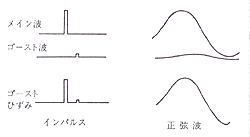 |  |
| <Fig. No. 4> Distortion not clear from sine wave | <Fig. No. 5> Self-correlative function (average of 1000 times for 6 minutes) for FM broadcast disk-jockey which has gone through the signal system with multipath-ghost distortion. |
The reason of discrepancy between conventional frequency characteristics and the sense of hearing.
If you check using this kind of measurement method, it will be clear that ghost distortion is generated not only from sound lens or some unevenness on the wall but also from previously mentioned prop and separator in the horn-type-speaker. Also this distortion will be generated at the corner from the wall point which abruptly starts expansion in a radial horn. Most horns in the market are not good regarding this point.
So we developed new type horn without multipath-ghost distortion. Fig. No. 7 and No. 8 show its characteristics.(I will explain about the details in another paper.)
You can get tone-burst response by convoluting impulse response and tone-burst wave using computer.
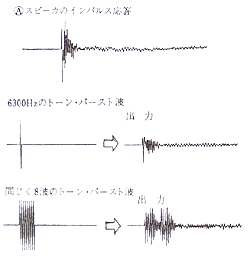 |
| <Fig. No. 6> Examples of impulse response and torn-burst responses |
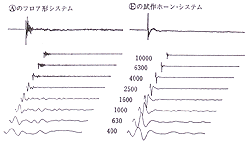 |
| <Fig. No. 7>> Examples of impulse response and Wave-1 torn-burst response |
Fig. No. 6 is the tone-burst response of the speaker which is on Fig. No. 1(A).
Burst wave is doubly multiplied by the multi-path ghost distortion.
In case of the same amplitude of the wave, it should be recognized differently between two different number of the waves. Wave-1 seems to be bigger regarding input/output ratio considering from amplitude and the number of waves.
You can get Fig. No. 7, if you calculate Wave-1 tone-burst response for each frequency. Also the response wave power is calculated, then normalized by the input power. It is plotted by round marking in Fig.No.8. These given characteristics are recognized as frequency response to the shortest signal on the sense of hearing .
In an ideal system, this will match with conventional frequency response by static sine wave. However, sound-tone must be different between transient and continuous sound in the system like (A), so at actual source, sound will be heard high-raised tone on average. We found another reason for the mismatch between conventional physical characteristic (frequency response) and the sense of hearing.
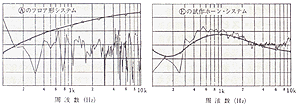 |
| <Fig. No. 8> The difference of the frequency characteristics against long signal and short signal. |
If you convolute the impulse response and music sound together, you can get the equivalent sound with microphone output which is same as when you play the instruments using its system.
The better point than an experiment by actual microphone output is we can repeat exactly the same sound as many times as we need.
See Fig. No. 9. It shows the experiment using xylophone. The experimental system shows all of its musical signal characteristics, generation of the sine wavefrom the impactive noisy sound which is produced by hitting xylophone with mallet, and also envelope of music sound. On the other hand, it looks like many musical information would be lost in the system (A). However it seems to sounds very gorgeous, so maybe some people consider it is a good sound.
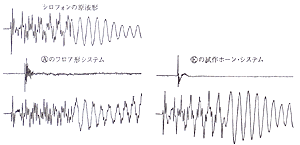 |
| <Fig. No. 9> Impulse response and the response to the sound of xylophone |
Distortion relating to amplitude
Operational difference between horn-type and corn-type
At present audio market in which frequency response is regarded as very important factor, 3 - 5 ways direct radiation type systems, namely corn-type /dome-type /flat-type etc. , are main trend.
On the other hand, some maniacs prefers the special sound of horn-type, however generally speaking, its sound is treated specially as a peculiar tone or considered as not suitable to playback high-faithful sound.
The peculiarity at the opening edge of the horn is very popular, and many researches have been done.
However, as mentioned in the part of multipath-ghost distortion, there was also another distortion in the high frequency region and forming its own characterized tone.
If you take away these peculiarities, a good factor on the horn
will be activated.
Actually there are many excellent points in this factor, and it is impossible to activate by another method. Let's think about one of these points, that is distortion.
Harmonic distortion which means "conventional physical characteristic" in this report will be connecting to high quality sound, if another factors have improved. However we have to evaluate not only quantity , but also the quality of the sound for music playback.
There is a possibility to create less distortion speaker in the horn-system than amplifier-system.
If you classify the electric to acoustic transformer in view of controlling the diaphram, it will be classified into three systems; elastic control system like head-phone, resistance control system like horn-type speaker, and inertial control system like direct radiation type speaker like corn-type /dome type /flat-panel type.
These three systems looks like the same from the point of sound producing method by vibrating the diaphram, however the truth is different. Each has unique chracteristics from the point of distortion generation. See Fig No. 10.
As the mass is the major factor in direct radiation type, diaphram is harder to move in the higher frequency. Therefore, the velocity characteristic will become right-side down. On the contrary, in case of head-phone, air density between ear and headphone will control the vibrating-part impedance, and getting become easier to move in higher frequency. In Horn type, vibrating-part is controlled by resistance in a certain frequency range where has enough electromagnetic regulation and horn load. And the velocity will be constant despite the different frequency.
Next, let's think about dislocation of the voice-coil/diaphram. Since the amount of dislocation is the integration of the velocity, the amount of the dislocation of the corn type is -12dB/oct and right-side down, that of horn type is -6dB/oct and right-side down, and that of head-phone is constant. Frequency response of sound pressure is always become flat, despite frequency response of velocity and the amount of dislocation are different.
That is to say, in corn type when frequency goes up, the velocity goes down, but the corn diameter is relatively larger than its wavelength, which radiation efficiency goes up. Also velocity and radiation efficiency will be constant for horn-type. For headphone, the amount of the dislocation is constant, and also the sound pressure level is constant.
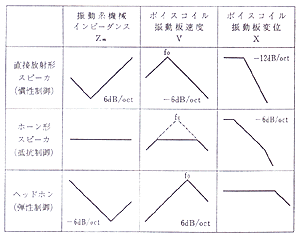 |
| <Fig. No. 10> Three kinds of frequency characteristics on electric, sound transformer. |
Few people understand that there are differences in diaphram dislocation behavior in each system. Also looks like many people consider that the amount of the dislocation of the diaphram and sound pressure waveform are similar in spite of the difference in frequency response. Even it is the same shape in sine wave, in music signal it will be different according to each system.
In Fig. No. 11, you can see some sound pressure waveforms varing the corn-type speaker output from small volume to large volume until the sound is distorted. Maybe some people cannot recognize the distortion waveform (above), however if you make a transformed waveform through integrator, you can understand that itself is a saturated waveform. In case of the corn-type speaker,
you can get the dislocation waveform through equalizing using -6dB/oct for velocity waveform, which means integration. (c.f. Fig. No. 10).
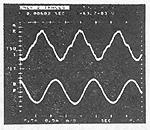 | 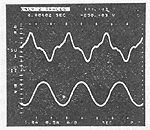 | 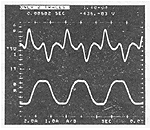 |
| <Fig. No. 11> Output sound pressure (above) and transporting point on the diaphram. Upper sound pressure is less. |
Less Distortion in Horn-Speaker
You can get Fig. No. 12 upon simulation in case that the distortion is generated from dislocation. The distortion difference becomes bigger for higher-order distortion. It is well-known that for music playback, the odd-order harmonic distortion is harmful, and also higher order distortion is harmful even if it is a small one.
These things make us convince the reasons for fairly good sounds from cheap head-phone, and horn-speaker sounds pretty good even though it contains some peculiarity. We calculated the difference of distortion between corn type(direct radiation type) and horn-type in Table No. 1. This difference will be getting bigger if you consider that dislocation distortion of horn type is less due to the narrow amplitude comparing to direct radiation-type. The distortion quantity could be less in addition to the good quality.
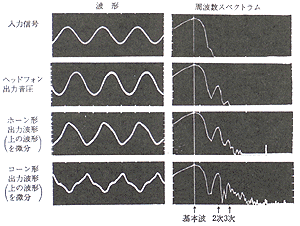 |
| <Fig. No. 12> Distortion waveform and spectrum of each system |
Fig No. 13 shows the distortion characteristics for the experimental horn-speaker. This has been measured at sound pressure 110dB as the distortion is under noise level of measuring system. If you measure at the normal level, the value will be much less. You do not have to concern about the second harmonic distortion. Regarding harmful third distortion, in normal listening level it will be under 0 dB and it cannot be heard.
It is reported that the harmonic distortion of the amplifier is about 0.003%. But this value is measured in maximum output using sine wave. Please check the distortion data of amplifier. In the condition of under the normal listening level 1W, this amplifier is inferior to our experimental speaker. Especially, the speaker will be superior in case of delicate sound as the speaker distortion will decrease, on the contrary to the increase of the amplifier distortion. Also as the quality of distortion is better in horn-speaker (high-order distortion is less), the amplifier will be inferior if absolute distortion volume is the same. As a matter of fact, if you listen into this type speaker, you will find out that most distortion is generated from the cartridge or amplifier. (To be continued.)
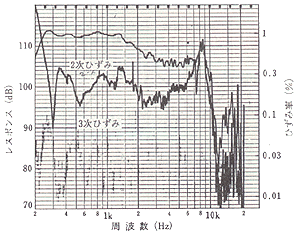 |
| <Fig. No. 13> Distortion rate characteristics on experimental horn-speaker |
|